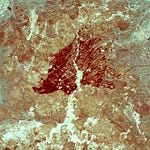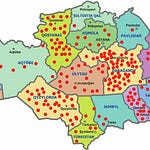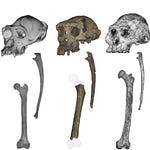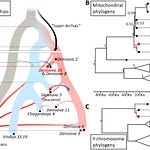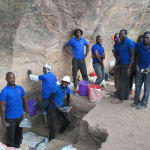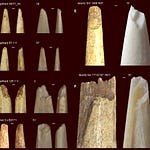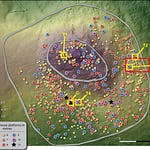In a quiet corner of southern Greece, far from the spotlight of famous Paleolithic cave art or towering megaliths, a scatter of tiny stone tools tells a story of ingenuity forged in the shadow of ancient elephants. At Marathousa 1, a 430,000-year-old site in the Megalopolis Basin, archaeologists have uncovered1 one of the earliest known examples of systematic animal butchery in the southern Balkans. But it’s not just the elephant bones that make the site exceptional.

The real revelation comes in the form of sharp-edged stone flakes—many less than four centimeters long. At first glance, these artifacts might seem like the debris of more important tools. But a recent study led by Dalila De Caro and colleagues argues that these so-called "microliths" were deliberate, effective instruments. And they weren’t just scattered by accident. They appear alongside the butchered bones of Palaeoloxodon antiquus, the now-extinct straight-tusked elephant.
"Our findings clearly show that small tools are not a sign of simplistic technology—on the contrary, they reflect a well-thought-out adaptation to the requirements of the respective environment," says archaeologist Vangelis Tourloukis.
A Lake, a Landscape, a Lifeway
Marathousa 1 sits beside what was once a Middle Pleistocene lakeshore. The landscape, with its mingling of forest and water, was rich in large herbivores, from deer and bison to hippos and elephants. The ecosystem also provided easy access to raw materials: radiolarite, limestone, quartz, and flint pebbles were carried by rivers and streams across the basin.
The inhabitants of Marathousa 1—likely early Homo species—exploited these resources efficiently. While we don’t yet have fossil evidence linking them to a particular hominin lineage, the tools suggest a nuanced and adaptive technological behavior. The people here were not simply striking rocks together. They were selecting materials, shaping blanks, and producing tools fine-tuned for specific cutting tasks, particularly animal dismemberment.
Precision in the Paleolithic
By analyzing over 2,000 artifacts, the team distinguished two core methods of tool-making: freehand percussion and bipolar reduction. Freehand flakes were struck directly from cobbles held in hand, while bipolar flakes were produced by placing stones on anvils and hammering them from above. The latter technique, long associated with expedience or low-skill, proved crucial for exploiting the region's small and irregular raw materials.
Multivariate statistical analysis of flake attributes—length, thickness, platform angles, ripple marks—revealed that most tools were not accidents of fracture but the result of intentional strategies. Small size, in this context, was not a technological limitation. It was a solution.
"The flexibility in the production of the tools required for this purpose shows how well these hominins adapted to their environment and efficiently used the available raw materials," says De Caro.
Elephants and Edge Maintenance
Butchering an elephant is no small task. The cutting edge of radiolarite, while sharp, dulls quickly—in experimental contexts, often within 30 minutes. This necessitated a constant supply of fresh flakes. The Marathousa toolkit reflects this demand. Alongside flakes are tools shaped for comfort and control: backed knives, scrapers, and notched implements, sometimes produced from exhausted cores or by repurposing waste material.
This is not a picture of early humans making do with what they had. It’s a snapshot of strategic decision-making. Toolmakers at Marathousa 1 selected only high-quality radiolarite cobbles from secondary deposits and appear to have tested raw material off-site, transporting only suitable blanks back to the lakeshore.
A Regional Puzzle Piece
The importance of Marathousa 1 lies not only in its technical revelations but also in its geographic and chronological context. It is the earliest securely dated archaeological site in Greece, and one of the southernmost examples of Middle Pleistocene megafauna exploitation in Europe.
This positions it as a key waypoint in understanding human dispersals through the Balkans—a region often overlooked in favor of more famous northern sites. The combination of small tool technology and large animal processing suggests that these early hominins were capable of flexible adaptation, taking advantage of seasonally abundant resources in a temperate refugium.
"In the future, we would like to clarify how such behavioral patterns developed in other parts of Eurasia and what role environmental factors played in this," De Caro notes.
Additional Related Research
Rios-Garaizar, J., et al. (2022). "Small flake production in the European Middle Pleistocene: New data from Ambrona, Spain." Journal of Human Evolution, 165, 103109. https://doi.org/10.1016/j.jhevol.2022.103109
Dibble, H. L., et al. (2017). "The role of artifact size and cortex in the interpretation of lithic assemblage variability." American Antiquity, 82(3), 498–510. https://doi.org/10.1017/aaq.2017.11
Schlager, S., et al. (2023). "Edge efficiency and flake morphology: Functional analysis of Lower Palaeolithic tools from Schöningen, Germany." Archaeological and Anthropological Sciences, 15(5), 98. https://doi.org/10.1007/s12520-023-01768-2
Organ, C. L., & Niewoehner, W. A. (2019). "Bipolar knapping in the Early Paleolithic: An experimental approach." Lithic Technology, 44(4), 213–227. https://doi.org/10.1080/01977261.2019.1663968
De Caro, D., Kuhn, M., Thompson, N., Panagopoulou, E., Harvati, K., & Tourloukis, V. (2025). Small flakes for sharp needs: Technological behaviour in the Lower Palaeolithic site of Marathousa 1, Greece. PloS One, 20(6), e0324958. https://doi.org/10.1371/journal.pone.0324958


